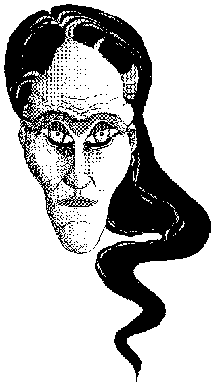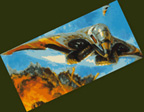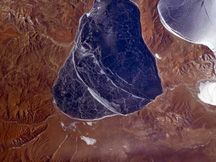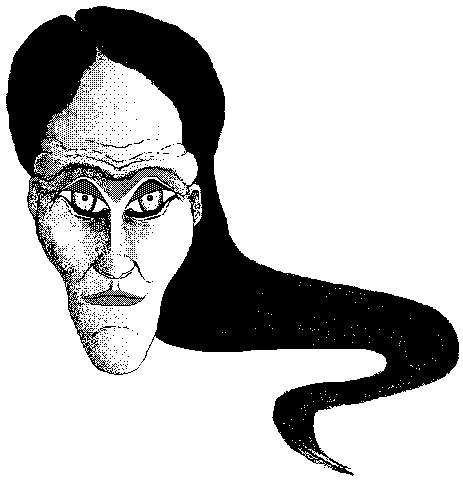

The History of a Race
(Excerpt from Genellan: First Victory)
Copyright©1996--2005 by Scott G. Gier
Ancient were the Ulaggi millenia before warlords mastered the
gravity-wracked planet of Kon and declared themselves noble. In that
timeless epoch, on a planet no longer spinning about a star, a curious
mating ritual played out. The species male migrated constantly in
quasi-social packs, through mountain valley, over wind-formed steppe,
and across grassy savannah. Brawny, short of limb, and dull of wit, the
plodding creatures gained protection in numbers and in constant
movement.
Stalking the hapless males were solitary huntresses, tall creatures and
quick.
Wary of the males' ability to wield sticks and throw stones, the long-striding females grew clever, learning to hunt in groups three. Yodeling maniacally, the females stampeded packs into helpless frenzy. Males that were separated from the pack, oftentimes with broken limbs, were run down by a fecund female and clasped to powerful coupling organs. The tortured body was ripped apart and implanted with the female's eggsack, her kar. The murderous huntress, trembling in the rapture of death, screamed with terrible ecstasy, serving notice of new life.
The depleted female, without backward glance, staggered away. The sundered male lay dying, his life blood and seed flowing across the steaming eggsack. Within the paternal corpse, kar maggots competed for existence, eating the putrid flesh of their father as well as destroying less active siblings. Statistically the surviving young were uniformly male. Infrequently a female egg was deposited among the multitude of eggs; on those rare occasions only one maggot would mature to term. Only one.
For this reason alone the evolution of the ur-Ulaggi into a socialized race was a glacial process. Yet the time came when predatory breeding was displaced with gender synergy. Evolution accelerated at that watershed, for males no longer needed to die at the alter of reproduction. Ulaggi science discovered benign methods of extracting male seed, substituting less sanguinary sustenance for the ravenous kar maggots. Population became a predictable commodity.
Brutish Ulaggi males came to participate in society, forming the bulwark of the agrarian and industrial workforce. The more intelligent males and the less militant females formed a grudgingly cooperative managing class. The aggressive female elite, exploiting a burgeoning work force, delved ever deeper into science and technology, relentlessly tightening its grip on power.
Ancient were the indomitable Ulaggi when the womb-planet died, blasted by a star gone nova. Yet the virulent race perished not. Anticipating their planet's demise, the Ulaggi probed the infinite void, desperate beings seeking viable sanctuary. The racial spark burned dimly, the thread of life century upon century so near breaking. Mutating as it probed, the erratic germ sought beneficent planetfall, evolving to survive, survival the only end.
Yet only the female evolved, for the wandering ships were crewed solely by that gender. The male, numbering uncounted billions, also traveled the stars but in seminal form, cryogenically preserved, employed clinically only as needed, never allowed to take living breath. Only female Ulaggi searched the timeless heavens, and of the female sex there came into being two mutations: lakk and hajil.

Centuries of space travel rendered bald aggression genetically counterproductive. Not surprisingly the most aggressive Ulaggi became the most adaptable, re-directing their truculence inward, adjusting to survival needs with polymorphic compensation. The race did not lose its belligerence, merely changed its focus; the complex Ulaggi brain bifurcated into dual cranial lobes, each with unique persona. The primary cerebellum developed heightened emotional control and an inchoate telepathic ability, an ability to perceive dendritic impulses. For a select few, this ability was extended; those exceptional Ulaggi progressively gained the ability to manipulate emotions.
The secondary cerebral lobe for Ulaggi females became a repository for suppressed emotions, a libidinous prison of atavistic personality, dominated by fear and sensuality. In this lobe resided the Ulaggi g'ort---the animal within.
As with most mutations, these tendencies were recessive and unevenly distributed. All female Ulaggi shared the tendencies, if not the intensity, of dual personality, but only one strain came to possess full-blown telepathic powers and the concomitant emotional pre-eminence. These were called lakk-Ulaggi. Those females not endowed or favored to a lessor degree, were known as hajil-Ulaggi. Through centuries of space travel hajil came to serve lakk, as once Ulaggi male served female.
Ancient were the Ulaggi when they fled their doomed planet and sailed without hope into uncharted space. Ultimately, one foray did not fail; one strain, bifurcated genetically by centuries in space, callused by sterile frustration, at last made orbit around the fourth planet of an impossibly distant star-system. How those time-hardened creatures, reduced to a few dozen extant organisms, must have rejoiced, gliding on orbit over the exquisite, white-spiraled atmosphere of a vibrant world. A treasure in time and space lay below them--a new home, at last within their grasp! For the taking. Take the Ulaggi did.
The first patrols of space-weary hajil to penetrate the verdant biosphere perceived no untoward danger. The air was full-bodied, the waters sweet. Thus assured, lakk-Ulaggi followed. Arriving on the unspoiled planet, their number dangerously reduced, the telepaths discovered in their new surroundings a mechanism for re-populating their withered ranks.
Pre-eminent among the aboriginal fauna of this fair and temperate
planet was a tool-using, bipedal, mammalian omnivore. From the moment
the first terrible squad of aliens stepped upon its soil, that innocent
creature's planet and its pristine freedom were forfeit, for in the
male of this species the Ulaggi discovered a surrogate host for their
unspeakable offspring.
The docile creatures died by the thousands, by the millions. And in each sundered carcass was implanted the fertilized eggs of an Ulaggi female. The indigenous beings came to be called kar, the Ulaggi word for egg-sack. Maggot-infested offal soon littered the new land, the rapacious larvae and the crawling young tending themselves, for egg-bearing Ulaggi were merely femaleãnever mother. The munificent planet was called Kar-Ulag.
Ancient was the Ulaggi civilization before man walked upright. When homo sapiens first seared the flesh of his kill, the Ulaggi race was fully rehabilitated on Kar-Ulag. Ulaggi males, squat, broad-shouldered and thick-chested, once again walked under bright sun, toilers of the fields and shepherds of the kar. Meanwhile, Ulaggi females mastered new technologies, new arts.
Meticulously, the Ulaggi peeled away the mysteries of hyperlight. Secure again on a world of their own, the Ulaggi ventured back into space, as explorers, seeking answers to the universe, seeking explanations for their being. The Kar system was situated on the edge of a star cluster, and within that cluster the Ulaggi perceived other life-supporting systems. Ulaggi ships probed outward, slowly, for the initial forays were made without hyperlight translation.
Then came the intoxicating domination of gravitronic flux. Where it had taken the Ulaggi a millenia to find their new home planet, within a single sun-cycle after harnessing the miracle of hyperlight the Ulaggi found two stars nursing abundant life. The Ulaggi Triad was established. The new planets, I'rd-Ulag and Tir-Ulag, were colonized, their indigenous life forms enslaved. And worse. Fate and the passing centuries developed unforeseen consequences. Another genetic derivative, an offshoot of the lakk, was established among the Ulaggi, only this infrequent mutation was an atavism.
Despite herds of kar kept in fertilization pens, a perverted strain of lakk-Ulaggi once again began hunting to breed, mutilating not only kar but Ulaggi males as well. This new female reveled in forbidden emotion; she unchained her g'ort, loosening the animal within. Thus was born the ur-roon, a fully telepathic, rapacious breeding organism, and thus was reborn the Ulaggi death-rapture. The ur-roon created new life, through savage, mindless death, glorious, orgasmic death.
Like the lakk, the ur-roon was but a thin trickle of the population, nevertheless the mutant strain generated social crisis. The stoic lakk-Ulaggi had created an orderly society, predictable and efficient, a society without laws, for there was no disorder; but Ulaggi society did have mores and custom and protocol. The ur-roon, given over to its animal, was walking chaos, endangering the ancient frameworks. Nay, the ur-roon was hurtling, screaming death, indiscriminately savaging kar and Ulaggi male, breeding prolifically.
The lakk made effort to remedy the problematic strain, but a mortal race once established is not readily excised. A culture, regardless of its perfidy, once passed to even a single generation is hallowed by its own bloodline. Conflict simmered into civil war lasting centuries, nearly destroying Ulaggi civilization. Hajil-Ulaggi and Ulaggi males were conscripted into action, terrified shield-carriers and expendable foot-soldiers serving both vicious roon and manipulative lakk. Desperate actions scarred the landscape of Kar-Ulag.
Unstoppable roonish-led battalions, their generals unmindful of death, swept one continent after another. The lakk, ever more desperate, ever more resourceful, retreated into defensive positions. The roon could not be defeated in combat, except by annihilation, for the roon rejected the rational trade-offs of warfare. The lakk, unable to destroy their rampaging sisters, sought answers in technology, in science, and in their own minds.
It was in the mind that the ultimate battle was fought, not on bloody fields. The beleaguered lakk at last deduced the roon's weakness; the secret was long in coming, for the roon's underbelly was also its whirling sword. The roon's liberated g'ort, that which gave the monster its indomitable ferocity, also represented the roon's greatest weakness; for the animal within was insane. As long as the roon's primary lobe was ascendant, the roon maintained sufficient rationality to ride the beast to bloody victory.
To eliminate or even slightly lessen the roon's control over its loosened animal was to create a frenzied killing machine, a beserker. The debilitating pathology became apparent; a general gone raving, blood-drinking insane made for a poor general. Lakk of the most powerful minds banded into psychological insurgency teams, focusing their melded powers on the generalship of targeted armies. Telepathic barriers were established, separating roon commanders from their g'ort. Roon's were reduced to slavering animals, horrible killing machines, impulsive yet predictable in their mindless, murderous state. The tide was slowly turned. The lakk prevailed, driving roonish generals mad and routing their panicked armies.
 Inexorably, if at
horrible cost, the lakk won back their planet. Millions of roon were
murdered, outright and over time, by enraged hajil, abetted by hordes
of Ulaggi male. No few perished under the surgeon's knife, for much was
discovered about the genetic syndrome, but no cure for the atavistic
disorder was realized. New roons were born every day; near two percent
of all Ulaggi fertilizations were roon, about the same percentage as
lakk. These newborn roons, called jik, were sterilized, lobotomized,
and relegated to the workforce. Not all. A fortunate few were spared
this pacification "cure" and were loaded into ships for the I'rd
System. The lakk, interested in the ways of the mind, and expecting the
roonish race to devolve into self-destructive chaos, initiated an
empirical study; a profound psycho-biological undertaking, and an
experiment better conducted on a planet other than their own.
Inexorably, if at
horrible cost, the lakk won back their planet. Millions of roon were
murdered, outright and over time, by enraged hajil, abetted by hordes
of Ulaggi male. No few perished under the surgeon's knife, for much was
discovered about the genetic syndrome, but no cure for the atavistic
disorder was realized. New roons were born every day; near two percent
of all Ulaggi fertilizations were roon, about the same percentage as
lakk. These newborn roons, called jik, were sterilized, lobotomized,
and relegated to the workforce. Not all. A fortunate few were spared
this pacification "cure" and were loaded into ships for the I'rd
System. The lakk, interested in the ways of the mind, and expecting the
roonish race to devolve into self-destructive chaos, initiated an
empirical study; a profound psycho-biological undertaking, and an
experiment better conducted on a planet other than their own.
Millenia passed. The planets of the Ulaggi Triad melded into a star-ranging empire, the seat of power shifting occasionally to Tir-Ulag, but ultimate control always wielded by the lakk, and far more often from the black marble edifices of Kar-Ulag. Dynasties rose and fell; cultures ebbed and flowed, the disparate races and genders of the Ulaggi seeking their natural place and order.
Surprising to lakk and hajil, after centuries of ungovernable chaos, the planet I'rd-Ulag flowered gloriously, dangerously. The planet derived its name from the indigenous I'rd, an intelligent, pre-industrial nomadic species. Physiologically, the I'rd did not support Ulaggi egg incubation, however the clever creatures were still viciously hunted by the roon, as bloodsport. The roon hunted to breed as well.
There came to be packs of Ulaggi male ranging the I'rdish territories, for the offspring of the wild roon, like the offspring of all Ulaggi females, were overwhelmingly male. Within a millenia a breeding equilibrium was established, made fascinating by a symbiotic alliance between the native nomads and the Ulaggi male. The I'rd, acting in their own self-interest, served as scouts and developed weapons, protecting the packs of aliens. The hunted males reciprocated with selfless devotion, using their numbers to shield the I'rd communities. This mutual endeavor did little to hinder the predatory carnage, but in their adversity, Ulaggi male and I'rd inexorably created a civilization.
In the final analysis, what saved the I'rd and Ulaggi male from morbid destruction was the balance of nature. There were very few hunters. The progeny of the ur-roon, if not male, were far more likely to be hajil than roon. The influence of the hajil on the advancement of the I'rd-Ulag civilization was dominant. Hajil tempered the excesses of the roon and exploited the burgeoning economic power of the I'rd/Ulaggi civilization. Over the centuries an enormous, technically capable workforce came into being. Roon governed, but hajil administered.
The I'rd-Ulag civilization became a system of laws, social and
scientific. Whole continents were forbidden to predatory breeding. The
ur-roon was transformed into the roon, molding to its survival needs,
bringing to heel its predatory instincts. Killing regions became
military training areas, stalked only with proper license to hunt. The
murderous roon proved adaptable beyond all expectations, creating new
technologies and opening new horizons. Roonish hyperlight ships, the
largest and most powerful of all Ulaggi ships, probed the galaxy,
searching for planets, some to colonize, but all to terrorize.
There were lakk on I'rd-Ulag. The planet was ostensibly governed by an imperial margrave, a hollow posting. Lakk scientists and imperial soldiery observed the society, at great risk. As the I'rd-roon civilization matured the lakk retreated to their telepathically secured citadels of imperial extraterritoriality.
The roon suffered the lakkish presence, but only as an economic link to the greater empire, and only as long as the lakk remained in their enclaves. In time Ir'd-Ulag came to rival the lakkish dominion of Kar-Ulag and Tir-Ulag. That time was now.
Tir-Ulag, the third jewel in the Ulaggi Triad, became of necessity the middle ground in the timeless internecine struggle between roon and lakk. On Kar-Ulag there were no free roon, only spayed drones. On I'rd-Ulag the rare lakk was imprisoned in her own telepathic fortress. It remained for Tir-Ulag to provide a neutral world and an uneasy equilibrium between roon and lakk.
Tir was the Ulaggi word for "cooperation." Although firmly under the imperial thumb, the long history of Tir-Ulag illustrated a persistent tradition of independent hajil leadership. On Tir-Ulag there were no primitive civilizations. Tir-Ulag, in its settlement period, was a jungle planet of saurians and reptiles. Its wild frontiers were hardship duty. The few lakk pioneers preferred to remain clear of peril, living in small groups on protected islands, or remaining in orbiting command posts. Many Tir-born lakk emigrated to the mother planet, rather than living lives of uncultured hardship. Hajil and even male-Ulaggi filled the leadership vacuum.
A roonish strain on Tir-Ulag was inevitable, but on Tir-Ulag the roon's need to hunt and kill was largely satisfied by the planet's fierce native fauna. Breeding was problematic, but the hajil majority prevailed, and modern conception methods were employed to the benefit of social advancement. A strong tradition of hajil independence and leadership arose.
Cooperation between the races was needed to settle the planet, and that spirit of mutual benefit was employed by the hajil to keep the lakk and roon populations in peaceful separation. The lakk controlled the countless archipelagos, building great universities. The roons slowly penetrated the dark interiors, settling thinly along the riverine systems, living in harmony with the more numerous hajil and male. As the continents were mastered, the hunting instincts of the Tir-roon turned to space exploration. This proclivity was promoted and abetted by Tir-hajil and Tir-lakk
Tir-lakk, with the help of space fleets crewed by Tir-roon and commanded by Tir-hajil, had on occasion even managed to wrest control of the empire. These dynasties were short-lived. The power that lakk and roon forged when working in concert was irresistible, but the glue that bonded the wielders of power together was as fragile as an emotion.
As disparate as the Ulaggi races and civilizations were, one to the other, they had far more in common. All Ulaggi -- lakk, roon, and hajil -- were neurotically compelled to conquer. The Ulaggi enslaved. If they could not enslave, the Ulaggi killed. Hajil, roon, and lakk all shared an abiding instinct -- kill to survive.
